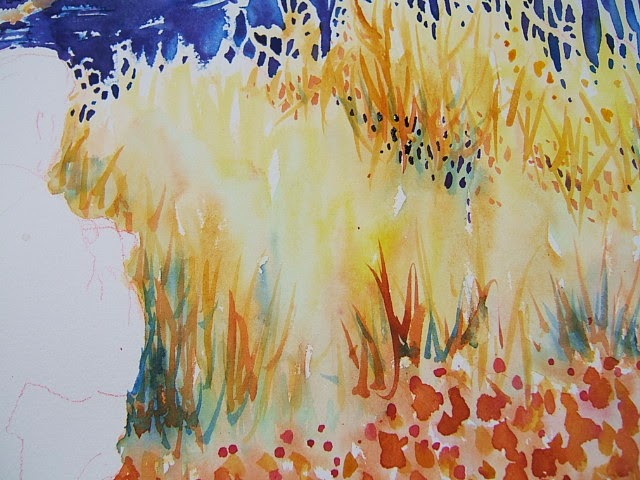I am working on a new piece called “Invitation: To
Proceed”. There is no one photo that captures what I wish to express. Often I
will combine several photos into one image. The perspective is tricky at times;
it is much simpler with one person or two as long as they are not too far
apart. In this case I chose a lonely figure who was walking at a slightly
different angle to the one I needed. So there were two problems to solve: angle
and proportion. I decided a thumbnail sketch was in order so I could determine
whether or not he should be dressed in dark or light clothing. The sketch gave
me the tonal value and the proportion, now all I needed was the angle. With
difficult problems such as this a preliminary sketch is a must. Trying to draw
a perfect figure onto the watercolour sheet with all the necessary changes and
without making any errors comes down to wishful thinking. It is much easier to
make all the mistakes on a cheap piece of paper then using a light table I can transfer it by tracing. I cut a chunk of Mayfield to the correct size and began
to draw. Changing the angle of the shoulders, hips, legs and feet proved not to
be as challenging as I had first imagined. I am very thankful for all the hours
I put into life drawing. They put flow into my work. Life is so good.
Monday, July 28, 2014
Monday, July 21, 2014
Preserving the Light
This is really about negative space again. My initial
washes are sloppy. I like soup and allowing the paint to do its own thing. Then
I experience control issues… Developing lighter grasses against a darker,
watery background contains several challenges especially if one wishes to
include some sparkle in the water. Once the first layer of grass has dried I
add strokes in different colours to encourage the illusion of grasses and
reeds. I then take the colours of the darker water and carefully open spaces in
the solid lighter areas to create thinner stems and seed heads. It is important
to use the same value of the background and maintain the line of the stems. It
does not have to look like the photo. It has to look like grass…. The
glittering water requires a more horizontal approach reducing the white spaces
sometimes to a few points, more often splitting the lighter area in two so
there are two fine sparkles instead of one big glob. One has to be choosy. It
is so easy to overwork this. Step back often and ask the question: is it
working? If the answer is ‘yes’, leave it alone. Enjoy!


Monday, July 14, 2014
Clean Wet Brushes
So what did I mean by clean wet brushes, large
and small in my last blog? These are essential tools to anyone doing
watercolour. A large moist brush without any pigment in it can smooth out a
hard edge, graduate colour into another area and sop up unwanted liquid. The
handy paper towel keeps the brush moist rather than loaded, a quick wipe and
the excess is gone. A good rinse in a container full of clean water helps to
reduce any surprise additions of colour in the wrong place, again with a quick
wipe on the towel. In the photo above you can see how a puddle of colour had
accumulated in one corner of the area in which I was painting. If left to its
own devices during the drying process a bloom would eventually occur. A bloom
is like a small bush-like spot that has a pale interior with a very hard, dark
edge. What happens is the excess water leaches the colour towards the drying
area and collects the pigment on the semi-dry edge as it evaporates. Sometimes
this is useful. Usually it is not. Dipping a dryish clean brush into the puddle
siphons the water and the pigment away. Several applications of the brush
leaves just the correct amount of water on the surface and it dries evenly. The
small clean wet brush is very useful for filling in small areas along edges and
perfecting the strokes. So much fun! Life is good.
Monday, July 7, 2014
Value Trays for Watercolour
 |
| Wet into Wet |
 |
| Jar Lids |
The surprises in watercolour are what keep me intrigued. One never has complete control over this media and as I continue using it I am less inclined to aim for complete control. Serendipitous blending produces the most magical results. The trick is recognizing when to leave things alone… To help create surprises I have happened on a system of value ranging that works very well for me. Value is the foundation for all colour and is therefore the most important. In the photo "Jar Lids" above you see a fine example of recycling: jar lids holding various liquids. I love jar lids. Usually the lightest washes are in the largest lids. They are the base into which I drop stronger and contrasting colours: wet into wet. The system works with the separation of three sources of value within each colour. The biggest lid holds the palest wash in each colour. Usually the largest brush is associated with this value. The smaller lid holds a much darker wash and the smaller brush goes with that. If I need even stronger contrast I can always dip into my paint tray which has been moistened with a water spray. So I have two lids, two brushes and three values for each of the colours I choose to use within each painting. The other essential ingredients are clean water brushes large and small and paper towel. So much fun! Life is so good!
Subscribe to:
Comments (Atom)






